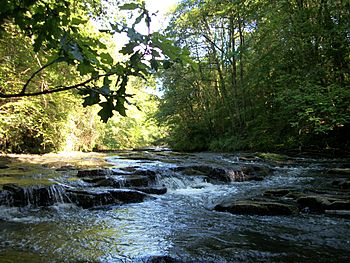Mouse Water facts for kids
Quick facts for kids Mouse Water |
|
|---|---|

Mouse Water as seen within Cleghorn Glen
|
|
| Country | Scotland |
| Region | South Lanarkshire |
| Physical characteristics | |
| Main source | 335 m (1,099 ft) |
| Length | 9.45 km (5.87 mi) |
| Basin features | |
| Progression | River Clyde |
| Tributaries |
|
The Mouse Water is a river in South Lanarkshire, Scotland. It's a smaller river that flows into the bigger River Clyde. This river is a fun place for people who enjoy canoeing.
In the past, the Mouse Water flowed very fast. This power was used to run mills and factories nearby. Even today, its strong current helps to create hydroelectricity. This is a clean way to make electricity using the force of moving water.
Amazing Gorges and Nature
The Mouse Water flows through two special natural areas. These are called Cleghorn Glen and Cartland Craigs. They are both "Sites of Special Scientific Interest" (SSSI). This means they have important plants, animals, or geology.
These two areas are also part of the Clyde Valley Woodlands National Nature Reserve. This reserve helps protect the beautiful forests and wildlife. The river has carved a deep gorge in these areas. This gorge was formed about ten thousand years ago. The Mouse Water slowly wore away the soft red sandstone rock.
Bridges Over the Water
Many bridges cross the Mouse Water. They help people and vehicles get from one side to the other. Here are some of the main bridges, listed from where the river starts to where it joins the Clyde:
- Cleghorn Bridge
- Cartland Bridge
- Mousemill Bridge

